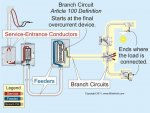I have been trying to calculate the voltage drop using the IEEE std.141
Vd = es + IRcos(theta) + IX sin(theta) + sqrt(es^2 - (IXcos(theta) - IRsin(theta))^2)
Inputs:
Number of conductors: Single
Conductor size: 1/0
Power factor: 80%
Load Current(Amps) 91
System voltage: 480
Length of Run (feet) 460
Conduit: EMT
I am coming up with 1.62% Voltage Drop
Am I correct?
Using the simplified formula V = I Rcos(theta) + I Xsin(theta) I get 1.95% Voltage Drop
Don't know which one is correct.
Thanks a lot
Vd = es + IRcos(theta) + IX sin(theta) + sqrt(es^2 - (IXcos(theta) - IRsin(theta))^2)
Inputs:
Number of conductors: Single
Conductor size: 1/0
Power factor: 80%
Load Current(Amps) 91
System voltage: 480
Length of Run (feet) 460
Conduit: EMT
I am coming up with 1.62% Voltage Drop
Am I correct?
Using the simplified formula V = I Rcos(theta) + I Xsin(theta) I get 1.95% Voltage Drop
Don't know which one is correct.
Thanks a lot


